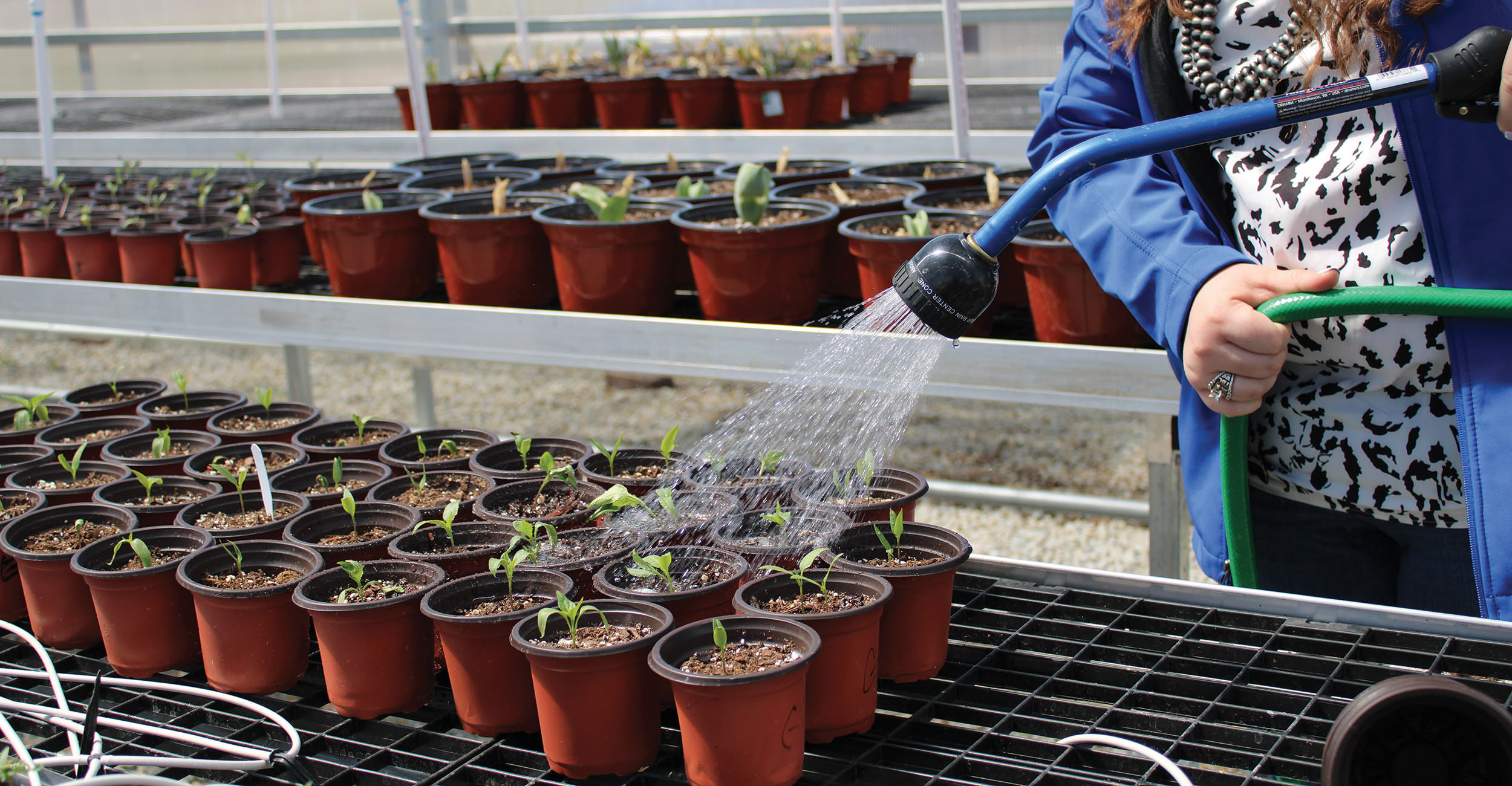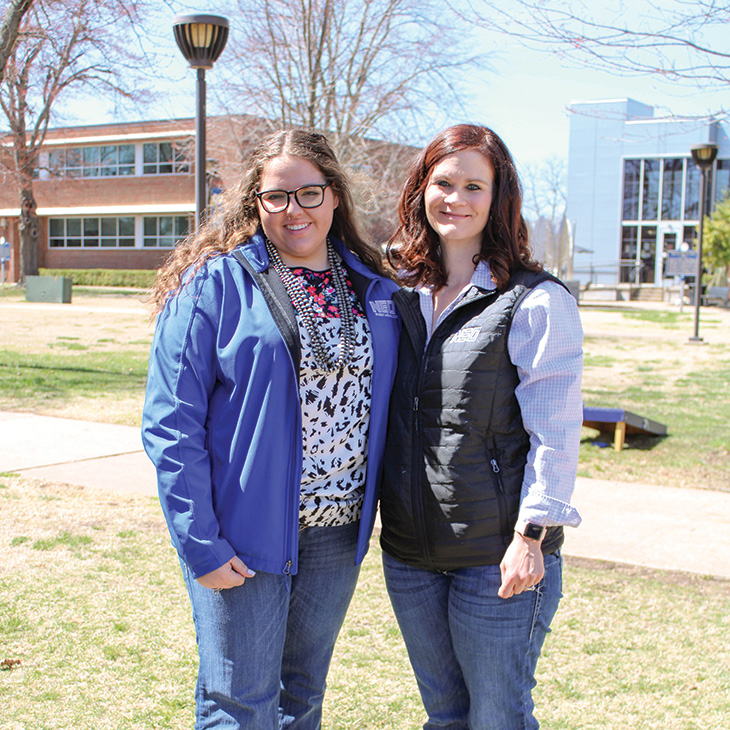
Growing New Beginnings
Friday, May 27, 2022
Media Contact: Jami Mattox | Agricultural Communications Services | 405-744-8061 | jami.mattox@okstate.edu
A collaboration between Oklahoma State University and Northeastern Oklahoma A&M College sparked a new opportunity for Native American students to attend both schools.
Established during the pandemic, PATHS to PROVIDE is a scholarship program for Native American students funded by two U.S. Department of Agriculture grants. Program participants learn the skills necessary to contribute to tribal food sustainability and food sovereignty, said Brian Arnall, plant and soil sciences professor at OSU.
“The need for this program tied heavily back to the sovereign nations ‘capability to be self-sufficient in food production,” Arnall said. “Not only can they produce for themselves as far as food goes, but they also make the students more marketable.”
Arnall said one of the main goals when the grants were written was to have more indigenous people complete undergraduate programs. Ensuring students received the resources to make it from freshman to senior year with a zero dropout rate was important, he added.
Each student in the program receives $30,000 in scholarships. They spend the first two years at NEO to complete an Associate of Science in agronomy. They finish at OSU with Bachelor of Science degrees in entomology and in plant and soil sciences.
When students complete the program, they graduate with three degrees and more than 25 career pathway options, Arnall said.
“We get all of their general education and core agriculture classes out of the way,” said Alisen Anderson, NEO agricultural instructor. “Some of these students have never been in the agricultural industry. They are a blank slate, and they learn to ask those critical thinking questions.”
On the other hand, some students in the program have deep roots in the industry and are eager to expand on their knowledge, Anderson added.
Teegin Crosthwait, a PATHS to PROVIDE scholar, said she was involved in many agriscience projects throughout her time in high school and was drawn to this program specifically because it focused on plant science research opportunities.
“Brian Arnall told me I needed to check out this program,” Crosthwait said. “I was set in stone about coming to OSU in the fall and only toured NEO to make Brian and my mom happy. As soon as I came to NEO, I realized I loved the campus and the people. I thought to myself, ‘Let’s do this.’”
Crosthwait said she enjoys being part of a small cohort because these students will be with her throughout her college career.
“One of the things I’ve learned is the importance of a team experience,” Crosthwait said. “Another thing I’ve learned in my first semester is this program is going to teach me about different sides of agriculture I knew existed but never really dug into.”
Upon acceptance into the program, Crosthwait received a $2,000 scholarship to purchase technology in addition to the tuition waiver.
“The scholarship is a very big blessing,” Crosthwait said. “Having this scholarship to help me get through my education means I don’t have to stress about having to pay back student loans when I graduate.”
The project is funded by grants from the U.S. Department of Agriculture National Institute of Food and Agriculture. The PATHS — Partnerships for Agrosecurity Training, Health and Science — grant comes from the Higher Education Multicultural Scholars Program. PROVIDE — Plant Resistance Of Vectors, Insects and Disease Education — came through the New Beginnings for Tribal Students. Thus, the name PATHS to PROVIDE was developed.
“There’s actually a little bit of history here,” Arnall said. “Dr. Wyatt Hoback recently had a cohort of five Native American students and brought them through the entire entomology program. This sparked the idea to create a similar program.”
Arnall said he was looking for opportunities for collaboration between Oklahoma schools.
“NEO A&M has a large proportion of students who are Native American,” said Hoback, an OSU entomology and plant pathology associate professor. “The OSU-Stillwater campus has about 10% of students who are of Native American heritage.
“NEO has students who have Native American affiliation, and NEO is closer to home for them,"

The thought process behind the collaboration was to allow students from small towns to attend a junior college to limit the shock of attending a four-year institution, Arnall said. The concept was to move these students as a cohort to give them a diverse industry background, so they could help their tribes and communities, Arnall added.
Building upon Hoback’s Native American student project, Arnall and Hoback submitted two grant applications to the USDA, Arnall said.
“It takes six to eight months to hear anything while applications are under review,” Arnall said. “We submitted PROVIDE, and then we came back and submitted PATHS, hoping to get one, and we got both.”
The program officially launched in Fall 2021 with six students, Anderson said. Students want to challenge how a traditional producer thinks, she added.
“The kids are in my office daily,” Anderson said. “They are incredible. We offer an important opportunity for Native American students to help their tribes and turn it into an education and into a lifestyle and an occupation.”
Between semesters at NEO, students participate in paid internships working on agricultural and horticultural research. At OSU, they will have a paid internship their junior year and research projects during the summer.
“The students select projects to investigate the effects of plant insect interaction, plant nutrition on animal feed, or how plants in a greenhouse respond to hydroponics,” Hoback said.
“They’ll get to design experiments and then collect data. We will help them interpret the data to help them do experimental design.”
Completing both entomology and plant and soil sciences degrees gives the students a more complete picture of the industry, Hoback said. This makes them better prepared to make decisions on the farm because they understand the agroecosystem, instead of just the plant side or the insect side, he added.
Each grant lasts four years, but this program will serve as a launching point for programs of the same nature, Arnall said.
“I have no doubt this will go somewhere else,” Arnall said. “In fact, we’ve been talking with other faculty who are looking at doing similar programs with other colleges.”
When a grant proposal is submitted, the authors promise knowledge will be gained from the proposal, Hoback said. Across the U.S., a strong desire exists to create a pipeline of students earning associate degrees and transitioning into universities to earn a bachelor’s degree, he added.
“What we hope is we learn, and the students help us improve the process,” Hoback said. “Down the road, maybe Oklahoma State could create cooperative agreements with other community colleges so the transition is seamless and the coursework doesn’t overlap but is complementary. Then, we can take these ideas outside Oklahoma.”
Be a PATHS to PROVIDE Scholar
High school seniors with Native American heritage who are interested in becoming a PATHS to PROVIDE scholar can visit the PATHS to PROVIDE website.
Northeastern Oklahoma A&M College and Oklahoma State University have complementary agricultural programs allowing them to collaborate and deliver an affordable education and unique student experience.
PATHS to PROVIDE allows students to get hands-on experience, scholarship and career path opportunities and three degrees.
The application can be downloaded through the site. It consists of general questions as well as two essay responses. Once completed, the application can be mailed or emailed to the addresses provided.
— pathstoprovide.com
Story By: Emily Garrett | Cowboy Journal
